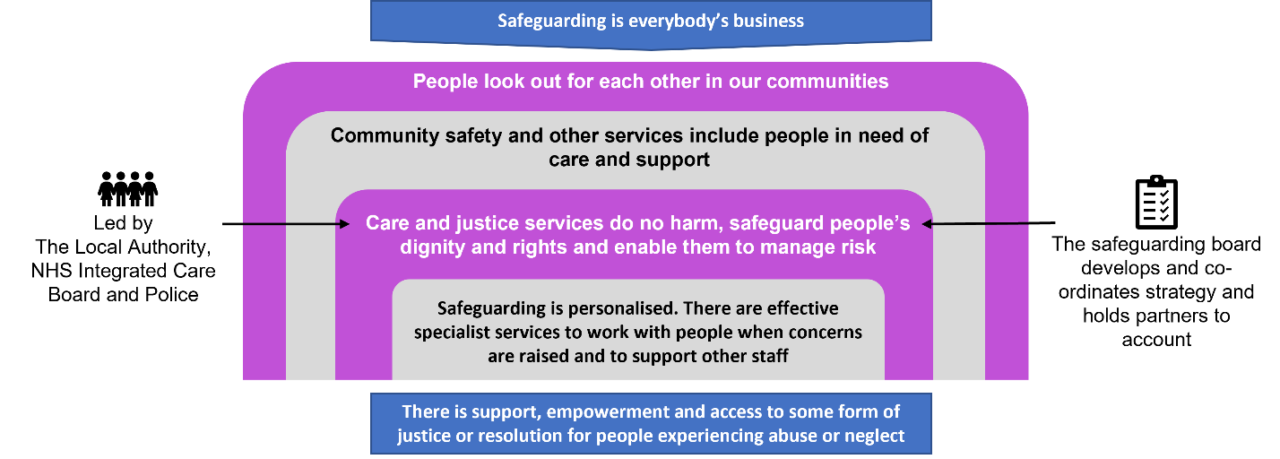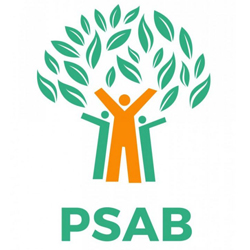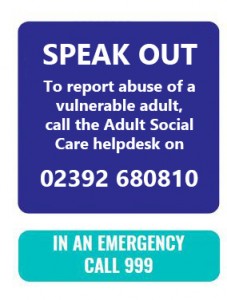What’s My Role in Safeguarding Adults?
Do you know what your role in safeguarding is? Safeguarding is for everyone. It’s not just about knowing your role in an employment setting but also about knowing your role as a human being in everyday life to promote safer cultures in the community. Today we want to highlight that safeguarding is everyone’s responsibility and that everyone needs to play their part to create safer cultures.

Multi-Agency Policy, Process and Guidance (July 2023)
This document sets out the overarching values and principles all agencies and organisations should be working to, the approaches to be taken to adult safeguarding and the process that explains how agencies and individuals should work together to respond to concerns of abuse and neglect of adults with care and support needs and be able and to put the policy, process and guidance into practice.
This document aims to ensure that there is an overarching approach to adult safeguarding embedded within all organisations across Southampton, Hampshire, Isle of Wight and Portsmouth and that there is a culture where the reporting of concerns of abuse and neglect is encouraged and that staff, volunteers and members of the public feel supported to do so.
4LSAB Adult Safeguarding Policy Process and Guidance July 2023
Safeguarding Roles and Responsibilities
The Care Act and its statutory guidance highlights the need for organisations to work together to prevent and reduce abuse and neglect of adults. Collaboration should take place at all the following levels:
- Operational
- Supervisory line management
- Practice leadership
- Strategic leadership within the senior management team.
- Corporate/cross authority.
- Chief officers/chief executives.
- Local authority members and the Police and Crime Commissioner.
- Providers of services.
- Voluntary organisations
The 4LSAB Multi-Agency Guidance on Adult Safeguarding Roles and Responsibilities outlines information about the above roles and their responsibilities to help all partners understand how their tole and organisation works together to support adults at risk of abuse or neglect.
4LSAB Multi-Agency Guidance on Adult Safeguarding Roles and Responsibilities (June 2020)
Resources from the Ann Craft Trust
Learn more about your role in safeguarding at the Ann Craft Trust’s website here
Sports and activity clubs are at the centre of communities. More information more about safeguarding in sport can be found here
The Power of Language in Safeguarding Practice: read the Ann Craft Trust’s blog here
Explore the guidance on terminology and racism from Sporting Equals here
Language Creates Reality: how Becca’s community project is revolutionising language use in health and social care. Find out more here
End the Awkward – it can be difficult to know how to talk about disability. Explore these free resources that offer support and advice to help end the awkward!
The Power of Language – a factsheet
The words we use can help us to build more positive cultures.
Jargon isn’t just confusing. It can also leave people feeling excluded and isolated.
Inclusive and accessible language can widen participation in services, organisations and communities.
Good communication is a two-way street. Don’t just aim to be understood. Aim to understand others too and ensure that everyone who wants to talk can have their say.
What is Adult Safeguarding?
This 4LSAB video provides information about abuse, how to recognise it and how to report concerns. Watch the video below.
Information for Professionals
E-Learning Resource for the Voluntary Community and Social Enterprise Sector
Trigger Tool e-Learning, developed by Connect to Support Hampshire is a free e-learning course aimed at volunteers, informal carers and anyone whose work in the community involves contact with potentially vulnerable people. The training covers working with all adult groups and provides a simple toolkit based on the risks and concerns which an individual may have when they visit or speak to someone. It is an awareness-raising and confidence-building tool covering a basic overview of topics in three broad areas: safe at home, physical and mental health, and supporting independence.
The training concludes with a comprehensive resource section which links to relevant information, advice and support services.
Please note: The above link will only work in Microsoft Edge if you have the latest chromium version installed. Alternatively, you can also switch to using another browser such as Firefox, Safari or Google.
SCIE Safeguarding Videos
Safeguarding adults: helping people to protect themselves from crime
What is the video about?
Care staff can help older people to protect against burglary and feel more confident at home. Practical advice such as using door chains, window locks and asking for identification are simple strategies older people can take to reduce the risk of burglary. In this video, older people who were robbed by distraction burglars and rogue traders are interviewed. They explain the shock, fear and deep disappointment such experiences can cause. Interviews with care staff illustrate this issue can be discussed without being patronising or making a person feel unduly concerned.
Who will find this useful?
Care workers in community settings; trainers of community staff; safety roadshows.
Safeguarding adults: looking out for each other to prevent abuse
What is the video about?
The film shows how good communication with older people can improve safeguarding. In residential care it is important that staff take the time to talk to residents and to listen to their concerns. Two community projects demonstrate how people are encouraged to look out for each other and to report any concerns about the safety of individuals. The Elders Forum based at the Malcolm X Community Centre in Bristol and the Ivybank House Residential Home in Bath both demonstrate how an open learning environment can encourage older people to speak out if they have seen or experienced abuse.
Who will find this useful?
Managers and front-line workers providing residential and community care.
Safeguarding adults: an independent life after abuse
What is the video about?
The film focuses on the personal story of Philip who suffered physical, financial and emotional abuse in the family home for many years. Philip has learning disabilities and cerebral palsy. When Philip finally disclosed the abuse, he was supported to leave the family home. Since then he has gone from strength to strength. He married and, although his wife unfortunately died some years after their marriage, Philip continues to live a full and independent life. Warning: This film contains strong language.
Who will find this useful?
Social workers; front-line care workers.
Safeguarding adults: teaching people to protect themselves
What is the video about?
This short film shows how training for people with learning disabilities can help them to protect themselves from abuse. People are helped to recognise what abuse is and to understand that they can and should say no. Each session involves a paid co-trainer who is an adult with learning disabilities. The training has also been adapted for groups of older people, people with physical disabilities and people who misuse substances.
Who will find this useful?
People working with people who are vulnerable to abuse; people working with people with communication problems.

